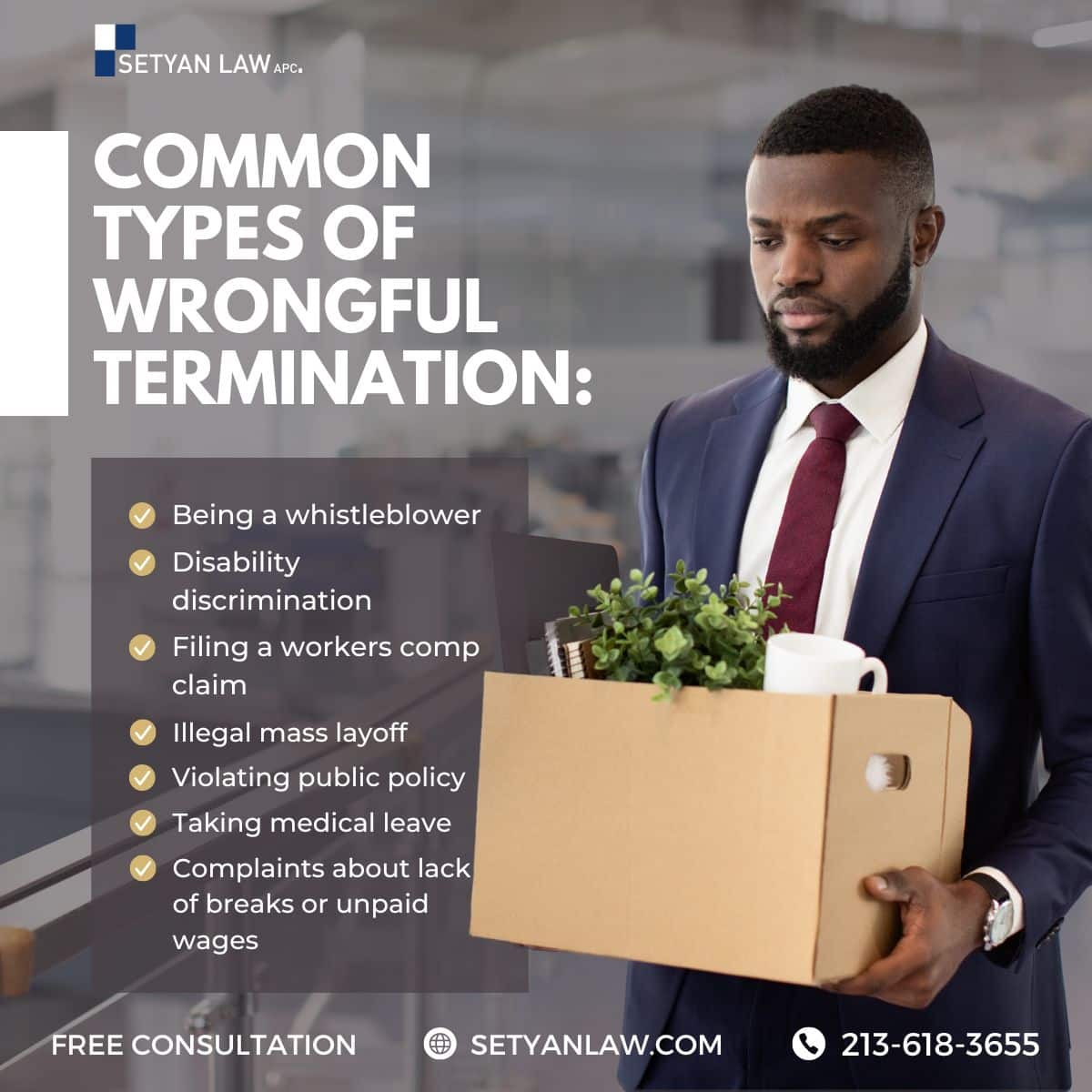Updated May 3, 2024
An Employer’s Legal Obligations
You’re probably already aware that employers have certain obligations to their employees, but do you know that you are protected by law from wrongful termination?
What is Wrongful Termination?
Wrongful termination is the unlawful firing of an employee. It happens when an employer fires a worker for an illegal reason, such as discrimination, or in violation of an employment contract. In the United States, most states have laws that protect employees from being wrongfully terminated, but there are some exceptions.
The most common grounds for wrongful termination are discrimination and retaliation. Discrimination is when an employer treats an employee differently based on race, gender, age, disability, or religion. Retaliation is when an employer fires an employee for legally challenging the employer’s actions.
Most Common Examples of Wrongful Termination:
There are many forms of wrongful termination. Here are the most common:
1. Discrimination: Firing an employee based on their race, gender, religion, age, or disability. This sometimes happens after long periods of harassment, or bad treatment. Finally, the employee had had enough, and that’s when he or she is fired.
2. Retaliation: Firing an employee for challenging the employer’s illegal practices, or reporting illegal activities.
3. Breach of contract: Firing an employee in violation of an employment agreement, such as a contract that says an employee can only be terminated for cause, or a contract that says an employee can only be terminated after a specific period of time.
4. Constructive termination: When an employer makes the work environment so hostile or unbearable that the employee feels forced to resign.
5. Public policy violations: Firing an employee for exercising a legal right, such as taking time off for jury duty or voting.
6. Violation of whistleblower protections: Firing an employee for reporting an employer’s illegal activities.
Proving Wrongful Termination
If you believe you have been wrongfully terminated, you will need to prove it. You will need to show that the employer’s decision was based on an illegal reason, such as discrimination or retaliation. You will also need to prove that the employer’s decision was not consistent with the terms of your employment contract, or that the employer violated public policy.
To prove wrongful termination, you will need to gather evidence. This could include emails, text messages, notes, or other documents that show the employer’s illegal or discriminatory motives. You may also need to speak to witnesses who can testify to the employer’s unlawful behavior.
Legal Implications of Wrongful Termination
Wrongful termination is a serious violation of the law, and the employer can face serious legal penalties. Depending on the state, an employer can be required to pay a fine, or even face criminal charges. The employee may also be able to sue for damages, including lost wages and compensation for emotional distress.
Common Signs of Wrongful Termination
If you think you might have been wrongfully terminated, there are certain signs you can look for. Here are a few of the most common:
- You were fired for an illegal reason, such as discrimination or retaliation.
- Your employer violated an employment contract or public policy.
- Your employer made the work environment hostile or unbearable.
- You were fired without warning, or without being given a chance to improve your performance.
- Your employer’s decision was arbitrary or capricious.
- Your employer failed to follow the proper procedure for termination.
Understanding Wrongful Termination Laws in California
The state of California has some of the most comprehensive laws in the country when it comes to wrongful termination. Under California law, it is illegal to fire an employee for an illegal reason, such as discrimination, or in violation of an employment contract.
In addition, California law also protects employees from being fired for exercising their legal rights, such as taking time off for jury duty or voting. It is also illegal for an employer to retaliate against an employee for challenging the employer’s illegal practices, or for reporting illegal activities.
How to Avoid Wrongful Termination
As an employer, it’s important to understand the laws and regulations governing wrongful termination. Make sure you’re familiar with all relevant state and federal laws, and that your policies and procedures are in compliance.
It’s also important to document all employee performance issues and to make sure you follow the proper procedure for termination. Make sure you give the employee the opportunity to improve their performance, and that you provide written documentation of any warnings or corrective action.
Tips for Avoiding Wrongful Termination Claims
In addition to understanding the laws and regulations governing wrongful termination, there are also some best practices you can follow to avoid wrongful termination claims. Here are a few tips:
- Have a written policy and procedure in place for hiring and firing employees.
- Train managers on the proper procedure for termination.
- Document all employee performance issues, and provide the employee with the opportunity to improve.
- Make sure all terminations are based on actual performance issues, and not on illegal reasons such as discrimination or retaliation.
- Have a system in place for addressing employee complaints and grievances.
- Make sure all communications with employees are professional and courteous.
Employer Responsibilities for Wrongful Termination
It’s the employer’s responsibility to ensure that all terminations are legal and in compliance with state and federal laws. If an employee believes they have been wrongfully terminated, the employer is required to provide evidence that the termination was legal.
The employer is also responsible for providing the employee with the opportunity to challenge the termination. This includes giving the employee the opportunity to respond to any performance issues, and to provide any relevant evidence that the termination was illegal.
What to do if Wrongfully Terminated
If you believe you have been wrongfully terminated, it’s important to take action. You should contact a qualified employment attorney who can help you understand your rights and determine the best course of action.
If you decide to pursue a legal claim, your attorney can help you gather evidence and build your case. Depending on the state, you may also be able to file a complaint with the Equal Employment Opportunity Commission or a similar agency.
Conclusion
Wrongful termination is a serious issue with significant legal repercussions. It’s important for employers to understand the laws and regulations governing wrongful termination, and to take steps to ensure they are in compliance. Employees should also be aware of their rights, and take action if they believe they have been wrongfully terminated. Understanding wrongful termination and how to avoid it is the best way to protect yourself, and to ensure a safe and fair work environment for all.
California employment cases can be complex. Your employer will likely fight back. You need someone on your side to protect your rights and get the money you deserve.
Call Setyan Law at (213)-618-3655 for a consultation.






